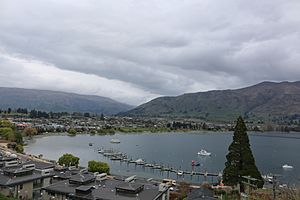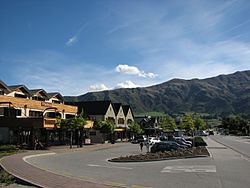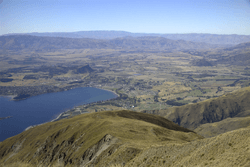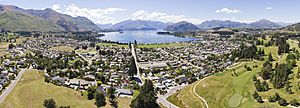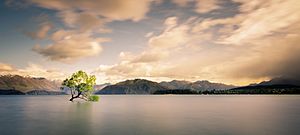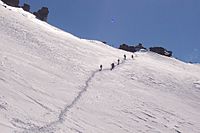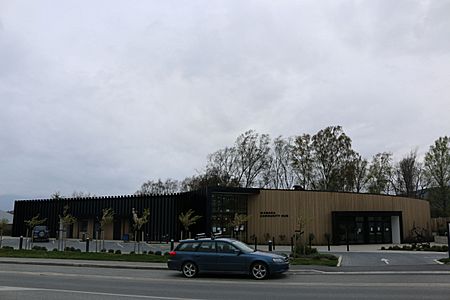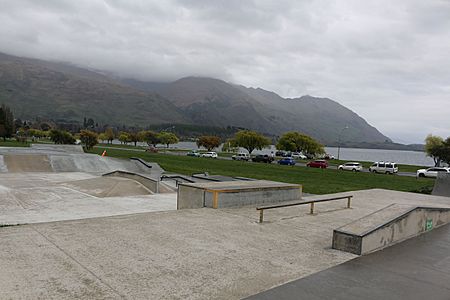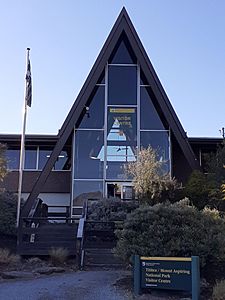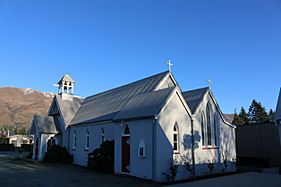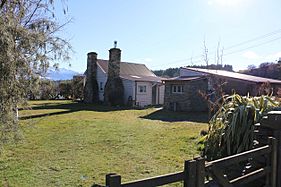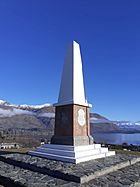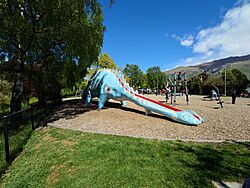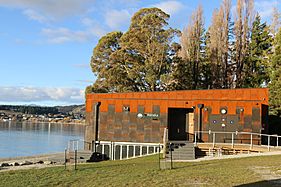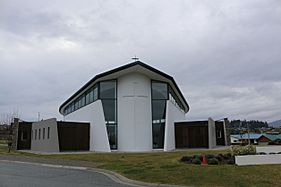Wānaka facts for kids
Quick facts for kids
Wānaka
Wānaka (Māori)
|
|
|---|---|
|
Town
|
|
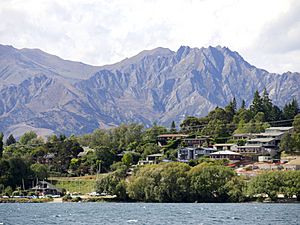
Wānaka east, with mountains in the background.
|
|
| Country | New Zealand |
| Region | Otago |
| Territorial authority | Queenstown Lakes District |
| Ward | Wānaka-Upper Clutha Ward |
| Community | Wānaka-Upper Clutha Community |
| Electorates |
|
| Area | |
| • Total | 28.61 km2 (11.05 sq mi) |
| Elevation | 290 m (950 ft) |
| Population
(June 2023)
|
|
| • Total | 12,400 |
| • Density | 433.4/km2 (1,123/sq mi) |
| Time zone | UTC+12 (NZST) |
| • Summer (DST) | UTC+13 (NZDT) |
| Postcode |
9305
|
| Area code | 03 |
| Local iwi | Ngāi Tahu |
Wānaka (Māori pronunciation: [ˈwaːnaka]) is a popular town in the Otago region of New Zealand's South Island. It's known as a great spot for both skiing in winter and summer adventures. Located at the southern end of Lake Wānaka, it's where the Clutha River begins and is the main entry point to Mount Aspiring National Park.
Wānaka is mostly a resort town. Its economy relies on the many outdoor activities it offers all year round. The town has grown quickly, with its population increasing a lot in recent years.
Contents
Discovering Wānaka: Its Name and History
What Does Wānaka Mean?
The name Wānaka comes from the Māori language. It's a South Island way of saying wānanga, which means 'sacred knowledge' or 'a place of learning'. Some people also think it means "the lore of the tohunga or priest".
Long ago, a Kāti Māmoe settlement here was called Para karehu or Parakārehu. Later, the Ngāi Tahu people had a settlement called Take Kārara near Lake Wānaka.
How Wānaka Got Its Name
The town was first surveyed in 1863 and named Wanaka. But it was quickly renamed Pembroke after a British politician, Sydney Herbert.
To avoid confusion with the lake, the town's name changed back to Wanaka in 1940. More recently, in 2019, the lake's official name became Lake Wānaka, and the town's name changed to Wānaka in 2021. The little line above the 'a' is called a macron, and it shows a longer vowel sound.
A Look Back at Wānaka's Past
The Kāti Māmoe people had a settlement called Para karehu where Wānaka is today. Later, the Ngāi Tahu people visited the area every year. They would hunt and fish in summer and look for pounamu (greenstone) in the mountains. They used reed boats called mōkihi to travel.
However, the Ngāi Tahu stopped using these lands after attacks from North Island tribes in 1836.
The first European to visit this area was Nathanael Chalmers in 1853. He was guided by Māori chiefs. European settlers started sheep farms in the 1850s. The town of Pembroke was officially surveyed in 1863.
The Gold Rush and Early Growth
In 1862, gold was found in the nearby Cardrona River valley, bringing many people to the area. Pembroke grew more in the 1870s because of timber cutting in the Matukituki River Valley. Lake Wānaka was used to transport the timber.
Tourism began in 1867 with the first hotel. The town got its first post office in 1873 and a school in 1880. Wānaka became very popular because of its climate and easy access to snow and water. With the opening of ski fields like Treble Cone (1968) and Cardrona (1980), Wānaka became a top winter spot.
Wānaka's Location and Climate
Where is Wānaka?
Wānaka is at the southern end of Lake Wānaka, surrounded by tall mountains. To the southwest, you'll find the Crown Range and the town of Queenstown. To the north, the Haast Pass goes through the Southern Alps.
Lake Wānaka is very close to the slightly smaller Lake Hāwea, separated by a rocky ridge called "The Neck". South of Wānaka, the wide Upper Clutha valley leads to Cromwell.
Wānaka's Unique Weather
Wānaka has a special climate, different from most of New Zealand. It has four clear seasons. The weather is quite dry, with spring being the wettest time.
- Summers are warm, with temperatures often reaching the high 20s Celsius (70s-80s Fahrenheit).
- Winters can be very cold, with daytime temperatures usually in single digits Celsius (30s-40s Fahrenheit). Nights are frosty, and it often snows.
| Climate data for Wānaka (Wānaka Airport), elevation 348 m (1,142 ft), (1991–2020) | |||||||||||||
|---|---|---|---|---|---|---|---|---|---|---|---|---|---|
| Month | Jan | Feb | Mar | Apr | May | Jun | Jul | Aug | Sep | Oct | Nov | Dec | Year |
| Record high °C (°F) | 35.2 (95.4) |
34.5 (94.1) |
30.8 (87.4) |
25.3 (77.5) |
23.9 (75.0) |
17.8 (64.0) |
17.2 (63.0) |
18.6 (65.5) |
22.6 (72.7) |
26.5 (79.7) |
31.4 (88.5) |
32.2 (90.0) |
35.2 (95.4) |
| Mean daily maximum °C (°F) | 23.8 (74.8) |
23.8 (74.8) |
20.7 (69.3) |
16.4 (61.5) |
12.3 (54.1) |
8.5 (47.3) |
8.1 (46.6) |
10.7 (51.3) |
13.8 (56.8) |
16.4 (61.5) |
19.1 (66.4) |
21.9 (71.4) |
16.3 (61.3) |
| Daily mean °C (°F) | 17.3 (63.1) |
17.2 (63.0) |
14.4 (57.9) |
10.8 (51.4) |
7.5 (45.5) |
4.3 (39.7) |
3.7 (38.7) |
5.7 (42.3) |
8.4 (47.1) |
10.7 (51.3) |
13.0 (55.4) |
15.6 (60.1) |
10.7 (51.3) |
| Mean daily minimum °C (°F) | 10.9 (51.6) |
10.6 (51.1) |
8.1 (46.6) |
5.2 (41.4) |
2.8 (37.0) |
0.1 (32.2) |
−0.6 (30.9) |
0.8 (33.4) |
3.0 (37.4) |
4.9 (40.8) |
6.9 (44.4) |
9.3 (48.7) |
5.2 (41.3) |
| Record low °C (°F) | 0 (32) |
0.2 (32.4) |
−1.7 (28.9) |
−4 (25) |
−7.5 (18.5) |
−8.2 (17.2) |
−8.6 (16.5) |
−6.6 (20.1) |
−5.7 (21.7) |
−3 (27) |
−2.5 (27.5) |
−0.4 (31.3) |
−8.6 (16.5) |
| Average rainfall mm (inches) | 55.4 (2.18) |
42.0 (1.65) |
45.7 (1.80) |
46.6 (1.83) |
60.2 (2.37) |
56.3 (2.22) |
46.2 (1.82) |
52.5 (2.07) |
50.0 (1.97) |
50.9 (2.00) |
54.5 (2.15) |
57.6 (2.27) |
617.9 (24.33) |
| Mean monthly sunshine hours | 231.5 | 201.7 | 182.6 | 164.0 | 135.5 | 120.5 | 126.6 | 155.8 | 172.5 | 193.8 | 202.2 | 212.1 | 2,098.8 |
| Source 1: NIWA | |||||||||||||
| Source 2: Lake Wanaka (sun) | |||||||||||||
Wānaka's Growing Population
Wānaka covers about 28.61 square kilometers. In 2018, its population was 9,552 people. This shows a big increase of 47.5% since 2013, and almost double since 2006!
Most people in Wānaka are of European descent (92.7%). About 5.2% are Māori, and smaller numbers are from Asian or Pacific Island backgrounds. Many people (28.9%) living in Wānaka were born overseas.
Fun Things to Do in Wānaka
Wānaka is a very popular place for tourists, known for its beautiful lake and mountain views. It's often seen as a bit more relaxed than nearby Queenstown.
You'll find many restaurants, cafes, and places to hang out in the evening. Other cool places to visit include Puzzling World, which has a maze and optical illusions. The Paradiso Cinema is a unique old movie theater with comfy couches instead of regular seats.
Near the Wānaka Airport is the National Transport and Toy Museum, full of old cars, planes, and toys. In winter, Wānaka is also a great spot to see the amazing Southern Lights.
Exploring the Mountains
Many mountains around Wānaka are great for climbing or hiking. These include Roys Peak, Mount Iron, Mount Grand, and the Pisa Range. From these spots, you can get incredible views of the area.
Don't forget "That Wānaka Tree"! It's a willow tree growing right in the lake and is a famous spot for photos.
Exciting Festivals and Events
Wānaka hosts many exciting festivals and events throughout the year:
- The Warbirds over Wanaka airshow happens every two years and attracts visitors from all over the world.
- The NZ Freeski Open is a big event for skiers.
- The Rippon Festival is a biennial New Zealand music festival.
- Challenge Wanaka Triathlon Festival is a major sports event.
- The Festival of Colour is an arts festival with theatre, music, and dance.
- Rhythm & Alps is a popular music festival.
- The Wānaka agricultural and pastoral show has been held since 1934, bringing together many people.
Wānaka on the Big Screen
The beautiful Wānaka region has been a filming location for many movies, including:
- The Lord of the Rings
- The Hobbit
- A Wrinkle in Time
Summer Adventures in Wānaka
Wānaka is perfect for outdoor fun in summer! You can enjoy hiking, mountain biking, rock climbing, fishing, paragliding, kayaking, rafting, and jetboating.
Mount Aspiring National Park is a top spot for mountaineering and hiking. Many tourists take day trips or even week-long hikes there. The Matukituki Valley, on the way to the park, is popular for rock climbing and short walks.
Lake Wānaka itself is great for waterskiing, wakeboarding, and sailing. The lake and local rivers also offer many chances for fishing. There's even a special mountain biking area and an 18-hole disc golf course.
Winter Wonderland Activities
Wānaka has the most snow activities in New Zealand! It's close to amazing ski fields like Treble Cone, Cardrona Alpine Resort, and Snow Farm. Wānaka is the main place to stay for these resorts, so it gets very busy in winter (July–September).
- Treble Cone is known for its great terrain for experienced skiers and snowboarders.
- Cardrona is more family-friendly and good for beginners. It also has one of the few Olympic-sized half-pipes in the world.
- Snow Farm is New Zealand's only place for cross-country skiing.
Wānaka also hosts many winter sports events, including the annual Winter Games.
Wānaka's Community Facilities
- Wānaka amenities
Swimming Pool
The Wānaka Recreation Centre has a 25-meter lap pool, a 20-meter learners' pool, and a hot pool. It opened in 2018.
Wānaka Community Hub
The Wānaka Community Hub is a home for 25 different community groups. It has a hall, a foyer, and offices. This building opened in October 2021.
Library
The Wānaka Library is on Dunmore Street. Besides many books, e-books, and audiobooks, it offers Wi-Fi and computers.
Golf Course
The Wānaka golf course, on Ballantye Road, was started in 1922. It now has 18 holes and is very popular with locals.
Mount Aspiring National Park Visitor Centre
The Tititea/Mount Aspiring National Park visitor center is a great place to get advice about walking and hiking in the national park. It also has a small museum about the park's history, animals, and plants.
Pembroke Park
Pembroke Park is a large grassy area (10.5 hectares) right by Lake Wānaka. It has a skate park and is a popular spot for locals and visitors to relax.
Important Buildings in Wānaka
- Notable buildings
Saint Columba's Anglican Church
This historic church was built in 1902 and finished in 1911. It's a special building with a Category 2 historic place listing.
Chalmers' Cottage
Chalmers' Cottage is another historic building from the 1870s. It was built for Archibald Chalmers, a butcher in Wānaka.
Wānaka War Memorial
The Wānaka War Memorial remembers the soldiers from the area who died in World War I and World War II. It's located on Chalmers Street.
Dinosaur Slide
A well-known feature at the lakefront playground is the dinosaur slide. It was built in 1976 and is a favorite for kids.
Wānaka Watersports Facility
This building is used by the Wānaka Rowing Club, Lake Swimmers, and TriWanaka. It won an architecture award in 2020 for its design.
Holy Family Catholic Church
The Holy Family Catholic Church was built in 2011. Its unique shape was designed to look like the mountains around it.
Schools in Wānaka
Wānaka has four schools for children:
- Holy Family School is a Catholic primary school for students in Years 1-8. It opened in 2006.
- Mount Aspiring College is a secondary school for Years 7-13. It was established in 1986.
- Wānaka Primary School is a primary school for Years 1-6. It opened in 1986 and moved to its current location in 2010.
- Te Kura O Take Kārara is another primary school. It opened in 2020 to help with the growing number of children in Wānaka.
All these schools welcome both boys and girls.
Getting Around and Services
Transportation in Wānaka
Wānaka has its own airport, Wānaka Airport. You can also reach Wānaka by road from different directions, including over the Crown Range and through the Haast Pass.
Daily bus services connect Wānaka to other major towns like Christchurch, Dunedin, Queenstown, and Greymouth.
Town Services
The town gets its electricity from a network operated by Aurora Energy. Fresh water for Wānaka comes from Lake Wānaka and is treated before it reaches homes.
In late 2021, Wānaka got a new, smaller Countdown supermarket, which means more choices for shoppers. There are also plans for a large film studio development, which will bring new opportunities to the area.
Famous People from Wānaka
- Tim Wallis – A pilot and businessman who started the Warbirds over Wanaka airshow. A street in town is named after him.
- Nico Porteous – New Zealand's youngest Olympic medalist.
- Zoi Sadowski-Synnott – New Zealand's first winter Olympic gold medalist.


